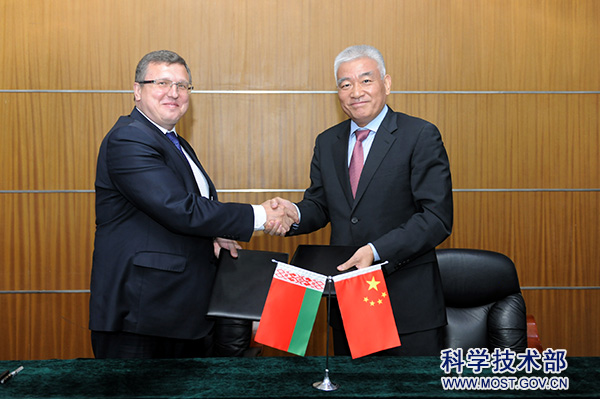
(Photo by Tian Feng/MOSTIC)
On September 4, 2018, the 2nd Meeting of the Sub-Committee on Science and Technology Cooperation of the China-Belarus Committee on Intergovernmental Cooperation was held in Beijing. The meeting was co-chaired by Wang Zhigang, Minister of Science and Technology of China and Alexander Shumilin, Chairman of the State Committee on Science and Technology of Belarus. Mr. Rudy Kiryl, Ambassador of Belarus to China, attended the meeting.
Minister Wang Zhigang said that since the establishment of diplomatic relations between the two countries in 1992, bilateral relations have been developing smoothly with frequent high-level exchanges. The purpose of this meeting was to deliver the important agreement between the heads of state on science and technology reached by of China and Belarus. Minister Wang Zhigang briefed the Belarusian side on China’s latest science and technology developments and progress in international cooperation. He stressed that the Chinese government will push forward with the implementation of innovation-driven development strategy, strengthen management of basic research, applied basic research and research commercialization, and actively integrate itself into the global innovation network. With the implementation of the Belt and Road Initiative, especially the four science and innovation action plans put forward by President Xi Jinping at the Belt and Road Forum for International Cooperation in 2017, there are now broader prospects for cooperation between the two sides. Belarus is China’s important partner for science and technology cooperation, and both sides have good relations and stable cooperation mechanisms. The two countries are complementary to each other in the field of science and technology. Minister Wang Zhigang remarked that MOST is willing to work with the Belarusian side to fully leverage the role of the Sub-Committee on Science and Technology Cooperation, promote bilateral cooperation in the field of science and innovation, turn the agreement between heads of state into practical results for the benefit of the two peoples.
Chairman Shumilin said that Belarus follows the progress of science and innovation in China. He reviewed and spoke highly of bilateral cooperation in the past. He also talked about Belarus’ science and innovation, national science programs and priority areas, and said that Belarus will actively engage in the Belt and Road Initiative based on its own advantages and development needs, so as to make China and Belarus“faithful friends”in the field of science and innovation.
At the meeting, the two sides reached agreement on deepening cooperation in science and innovation. The two sides agreed to expand people-to-people exchanges between the two countries within the framework of the sub-committee, sponsor exchanges and mutual visits by researchers, jointly organize science and innovation events, deepen cooperation in practical R&D projects, promote the building of long-term cooperation platforms, and actively push forward the implementation of projects in the Great Stone Industrial Park. Finally, the two sides signed Minutes of the Second Meeting of the Sub-Committee on Science and Technology Cooperation of the China-Belarus Committee on Intergovernmental Cooperation.
The China-Belarus Committee on Intergovernmental Cooperation in Science and Technology was established in accordance with the Intergovernmental Agreement on Science and Technology Cooperation between China and Belarus signed in 1992 and is jointly led by the Ministry of Science and Technology of China and the State Committee on Science and Technology of Belarus. In September 2014, China-Belarus cooperation in science and technology was formally incorporated into the framework of the China-Belarus Committee on Intergovernmental Cooperation and a sub-committee on science and technology cooperation was established. In principle, the sub-committee meets every two years to report on the latest science and technology policies and the status quo of science and technology development in the two countries, hold exchanges on the progress of bilateral science and technology cooperation, and set directions for future cooperation.

